Diseases
Diseases Affecting Heads and Grain

Common Bunt
Wheat kernels infected by common bunt have a gray-green color and are wider than healthy kernels. Diseased kernels can be seen in developing wheat heads but are often not detected until harvest. The outer layers of diseased kernels remain intact initially, but are easily broken during grain harvest, releasing masses of black, powdery spores. The fungus produces chemicals with a fishy odor, which sometimes causes this disease to be referred to as “stinking smut.”
Management: Fungicide seed treatment, disease-free seed sources.
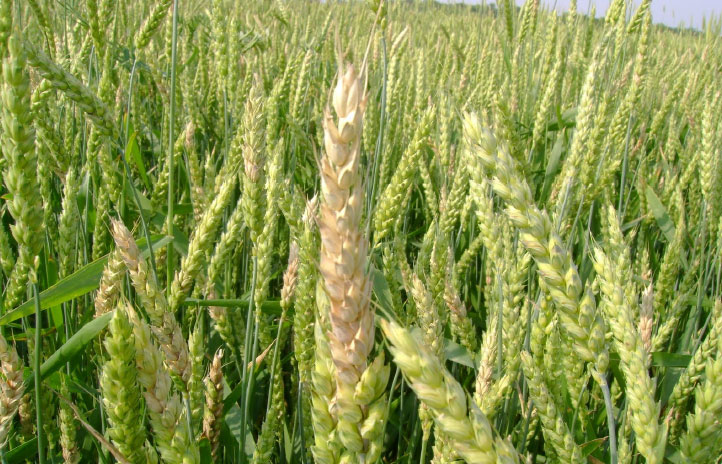
Fusarium head blight
Symptoms of Fusarium head blight include tan or light brown lesions encompassing one or more spikelets. Some diseased spikelets may have a dark brown discoloration at the base and an orange fungal mass along the lower portion of the glume. Grain from plants infected by Fusarium head blight is often shriveled and has a white chalky appearance. Some kernels may have a pink discoloration.
Management: Avoid the most susceptible varieties, avoid planting into corn residue, foliar fungicides.
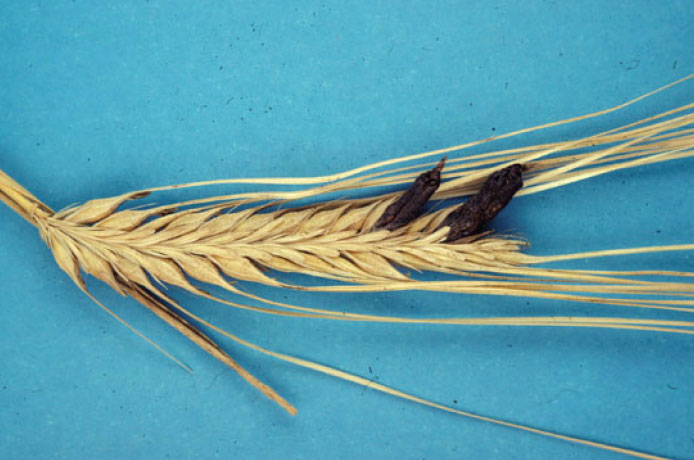
Ergot
Ergot is a fungus, an ascomycete, that forms sclerotia, ascospores and conidia. The sclerotia vary in size (2-20 millimeters long), depending on the host’s seed size which the sclerotia replace, and are purple-black, elongate (spur-like) with white centers. Ascospores are long, thin and septate; conidia are small, round and one-celled.
Management: Use sclerotia-free seed and implement crop rotation with non-host crops such as legumes, corn and sorghum.
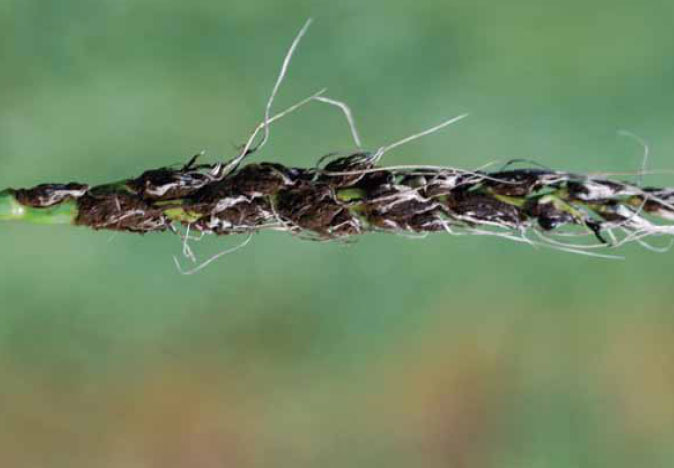
Loose Smut
The normal head tissue of plants infected by loose smut is completely replaced with dark masses of fungal spores, giving the heads a black powdery appearance. It is possible to see heads damaged by loose smut while much of the head is still inside the boot. Only the central stem of the head is left after the spores are released.
Management: Fungicide seed treatment, disease-free seed sources.
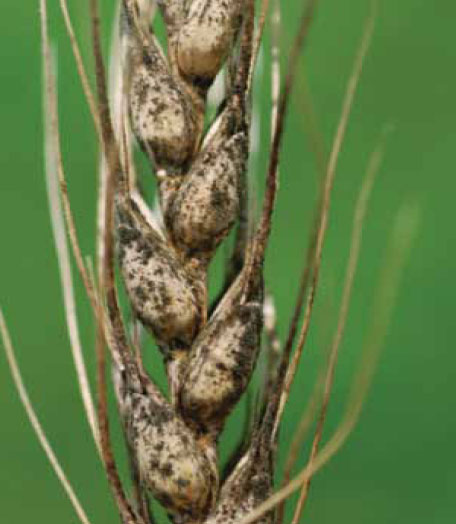
Sooty Head Molds
Sooty head molds are characterized by a dark green or black mold growth on the surface of mature wheat heads. These molds are part of a naturally occurring complex of organisms that help to decay dead plant debris. Sooty molds are most common when mature wheat is subjected to repeated rains and delayed harvest. This disease also may affect plants that have been damaged by root rot. The sooty head mold growth is normally superficial. Its affect on grain is thought to be minor, but it can make for dusty harvest operations. Sooty molds can contribute to a discoloration of the grain called “black point.”
Management: Generally impractical or not needed.
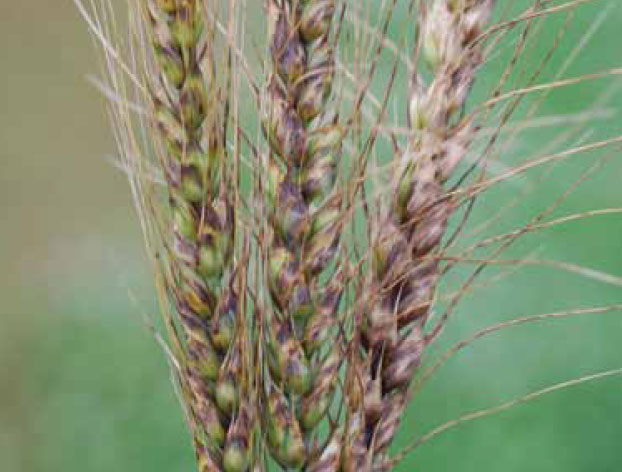
Stagonospora nodorum blotch
This disease causes dark brown or purple lesions on heads. Lesions are often more intense at the top of the glume, with brown streaks or blotches extending down toward the base of the spikelet. The presence of tiny fungal reproductive structures embedded in the tissue can confirm the diagnosis but will require significant magnification.
Management: Genetic resistance, foliar fungicides, crop rotation, fungicide seed treatment.
Diseases Affecting Leaves
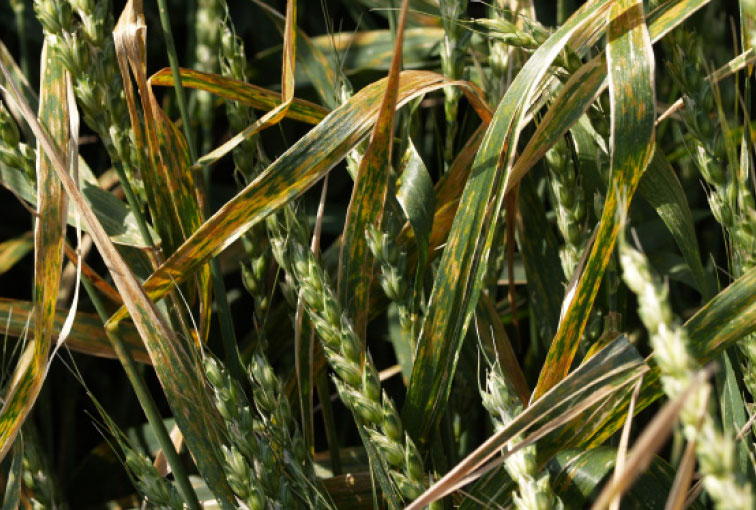
Bacterial streak
Early symptoms of bacterial streak include small, water soaked areas between leaf veins. These water-soaked areas become tan streaks within a few days. When the disease is severe, streaks may merge to form large, irregular areas of dead tissue. When dew is present, the bacteria causing this disease may ooze from the lesions and dry to form a clear, thin film. This film flakes easily and is visible when the leaf is viewed from different perspectives.
Management: Avoid highly susceptible varieties.
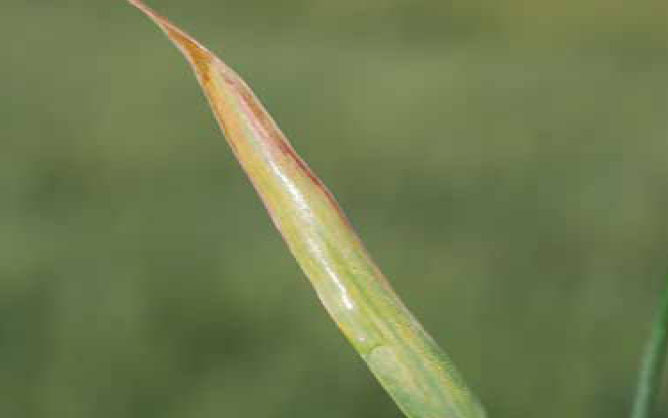
Barley yellow dwarf
This viral disease causes wheat leaves to have a yellow or red discoloration. The discoloration is often more intense near the tip of affected leaves, giving them a flame-like appearance. Barley yellow dwarf often occurs in patches within a field. The size and distribution of these patches
depends on the feeding activity of aphids which spread the barley yellow dwarf virus. Infected plants within these patches may be shorter than neighboring healthy plants.
Management: Genetic resistance, delayed planting date, insecticide seed treatment.
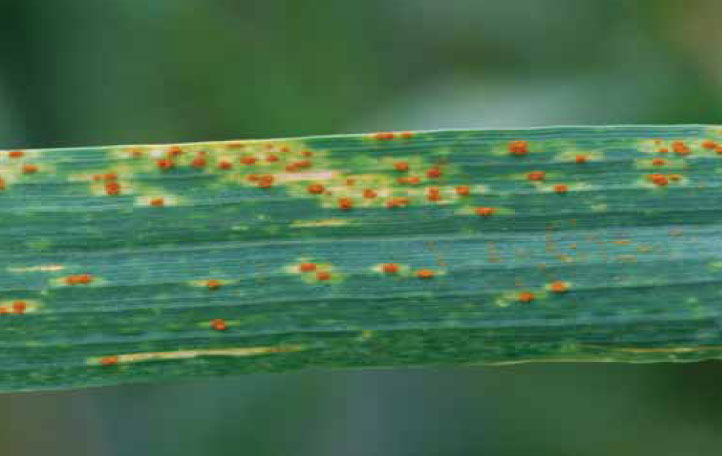
Leaf rust
Small, orangish-brown lesions are key features of leaf rust infections. These blister-like lesions are most common on leaves but can occur on the leaf sheath, which extends from the base of the leaf blade to the stem node. Lesions caused by leaf rust are normally smaller, more round and cause less tearing of the leaf tissue than those caused by stem rust.
Management: Genetic resistance, foliar fungicides.
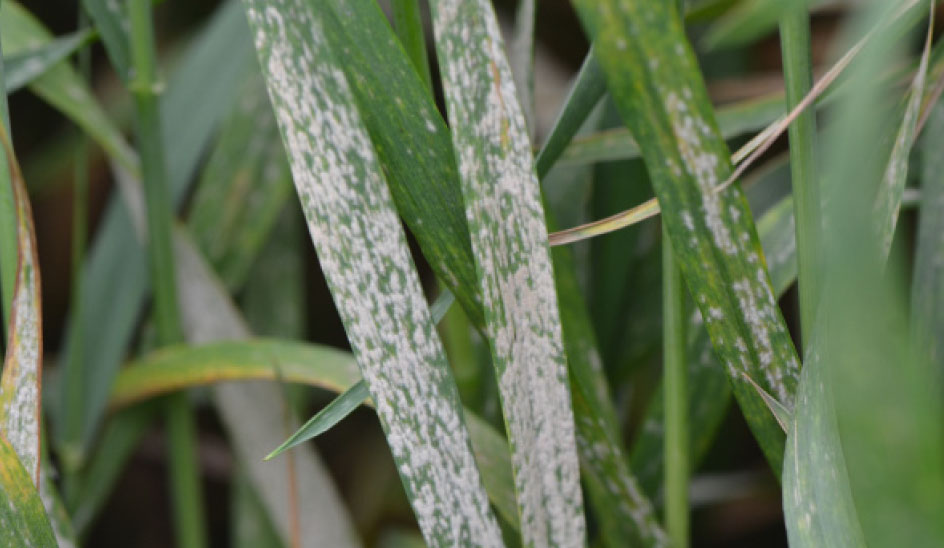
Powdery mildew
Powdery mildew causes white lesions on leaves and leaf sheaths. Glumes and awns also can be infected when the disease is severe. Fungal growth is largely limited to outer plant surfaces and can be easily wiped away by rubbing a finger across affected areas. Mature lesions may have dark, reproductive structures mixed with the white, cottony growth of the fungus.
Management: Genetic resistance, foliar fungicides.
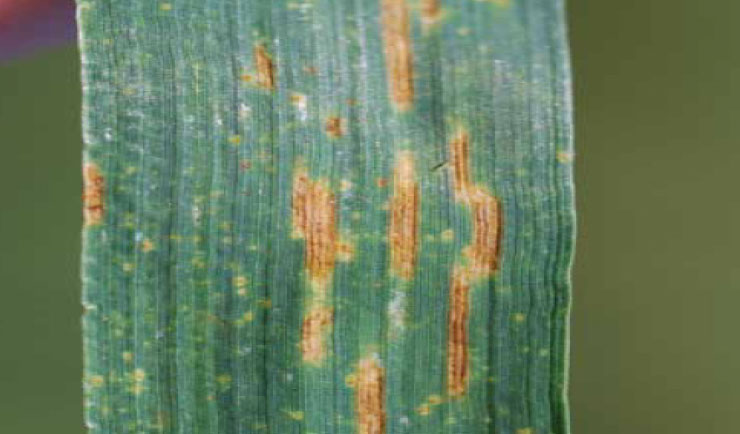
Septoria tritici blotch
This fungal disease causes tan, elongated lesions on wheat leaves. Lesions may have a yellow margin, but the degree of yellowing varies among varieties. The dark, reproductive structures produced by the fungus are key diagnostic features and can often be seen without magnification. This disease is also known as speckled leaf blotch.
Management: Genetic resistance, foliar fungicides, crop rotation.
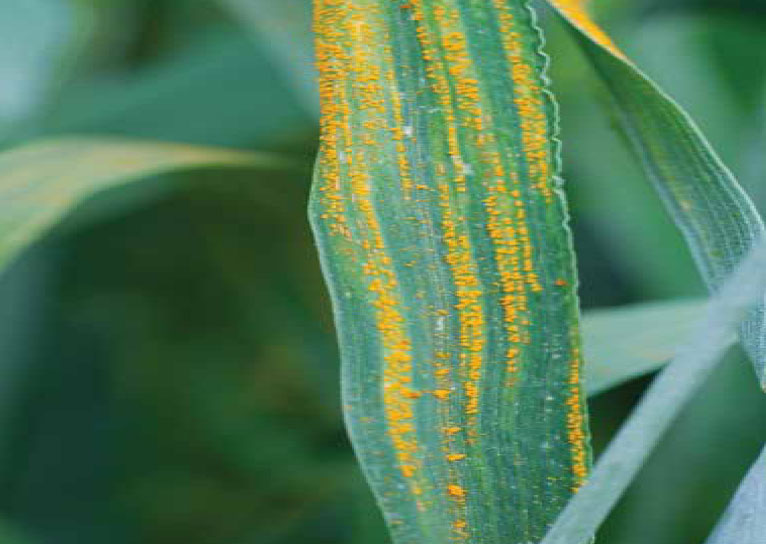
Stagonospora nodorum blotch
The lesions of Stagonospora leaf blotch are normally brown or tan and surrounded by a thin, yellow halo. Lesions caused by Stagonospora leaf blotch are more irregular in shape and often have a darker color than those of tan spot. The presence of small, honey-colored fungal reproductive structures is diagnostic for Stagonospora nodorum blotch; however, these reproductive structures are only visible with considerable magnification.
Management: Genetic resistance, foliar fungicides, crop rotation, fungicide seed treatment.
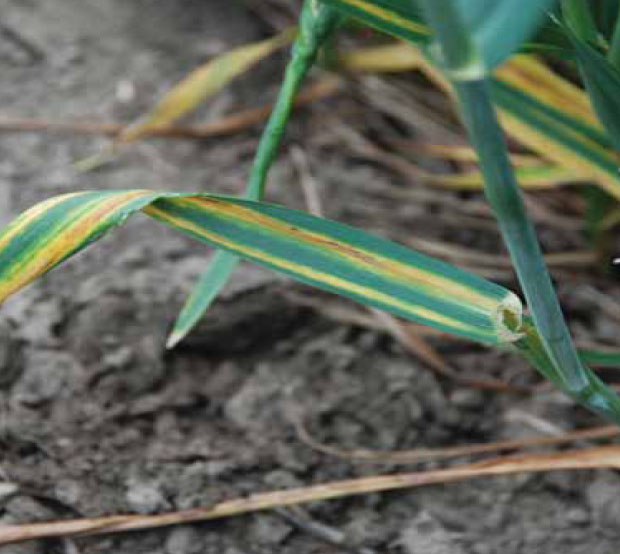
Cephalosporium stripe
Plants infected with Cephalosporium stripe have pronounced yellow stripes running the full length of the leaf blade. The center of the yellow stripe may have a long, brown streak that extends onto the leaf sheath. Splitting the stem of infected plants often reveals small brown streaks within the node tissue. Cephalosporium stripe can also cause areas of stunted, irregular growth within a field. Often, infected plants die prematurely, causing patches of white heads within a field.
Management: Genetic resistance, crop rotation, control grassy weeds.
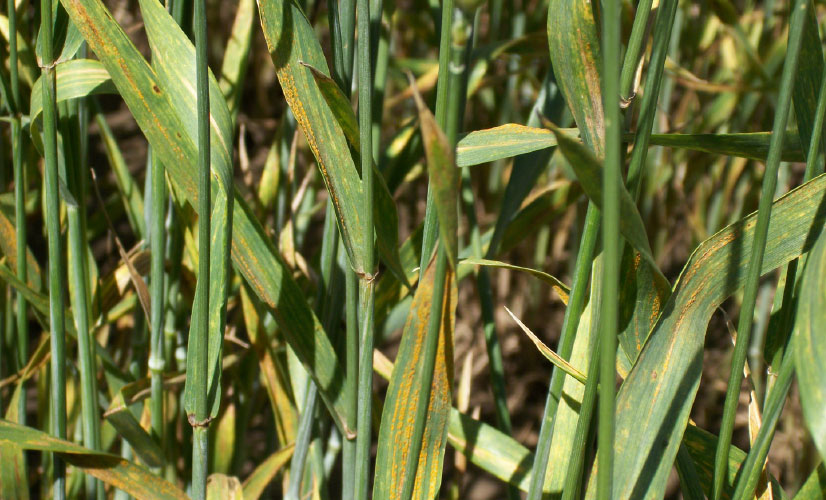
Stripe rust
Stripe rust causes yellow, blister-like lesions that are arranged in stripes. The disease is most common on leaves, but head tissue also can develop symptoms when the disease is severe. Outside the United States, this disease is sometimes referred to as yellow rust.
Management: Genetic resistance, foliar fungicides.

Tan spot
The key diagnostic feature of tan spot is tan lesions with a yellow margin. Mature tan spot lesions often have a dark area in the center. Lesions may merge as they expand, resulting in large sections of diseased leaf tissue. The fungus that causes tan spot survives in the debris of previous wheat crops and produces small black reproductive structures in the spring.
Management: Avoid planting into wheat residue, tillage where appropriate, genetic resistance, foliar fungicides.
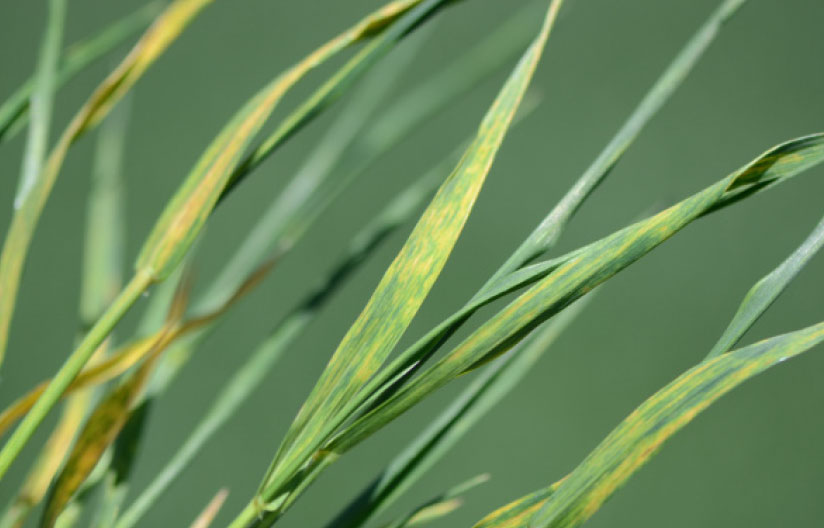
Wheat soilborne mosaic
Winter wheat infected by wheat soil borne mosaic develops a pale-yellow discoloration shortly after breaking dormancy in the spring. The incidence of wheat soil borne mosaic is often greater in low areas of a field where moist soil conditions favor growth of the protozoa that spread this viral disease. Leaves of infected plants often have a mosaic pattern of dark green blotches on a pale yellow background. Symptoms normally fade when warm weather slows the viral activity within infected plants.
Management: Genetic resistance.

Wheat spindle streak mosaic
Wheat spindle streak mosaic causes a yellow discoloration to wheat seedlings. This yellow discoloration is often most intense in the wettest areas of a field. Leaves of infected plants have long, yellow streaks that are slightly wider in the middle than at their ends. Symptoms are similar to wheat soil borne mosaic, and plants often are infected with both diseases.
Management: Genetic resistance.
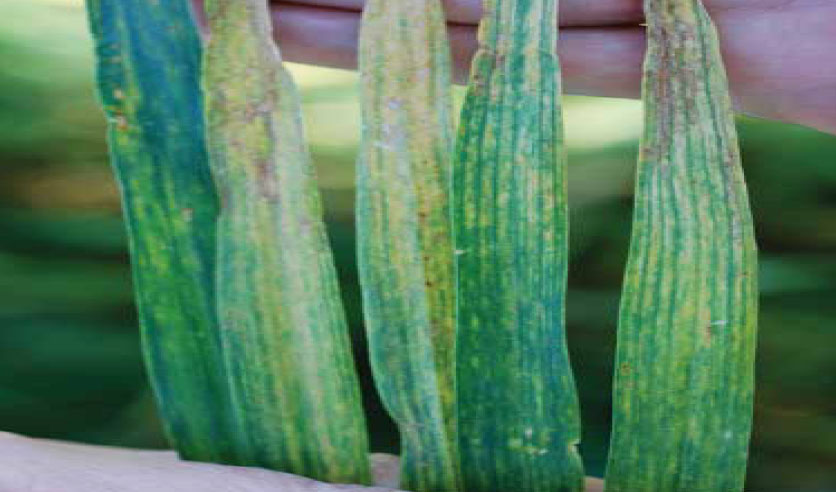
Wheat streak mosaic
Leaves of plants infected with wheat streak mosaic have a bright yellow streaking. Symptoms are often most severe near the leaf tip. The virus that causes wheat streak mosaic survives in volunteer wheat and is spread by wheat curl mites. The disease is often most severe in areas of a field that are closest to these sources of the disease and mites. Commonly, plants infected with wheat streak mosaic are also infected with High Plains disease and Triticum mosaic. The symptoms of these diseases are nearly identical. Disease severity is greater when plants are infected by more than one virus.
Management: Control volunteer wheat, delayed planting date, genetic resistance, avoid planting near maturing corn.
Diseases Affecting Stem and Roots
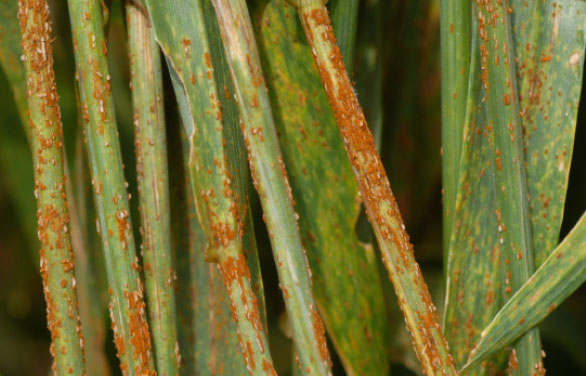
Stem rust
Stem rust causes blister-like lesions on leaves, leaf sheaths and stems. Infection of glumes and awns is also possible. The reddish-brown spores of the fungus cause considerable tearing as they burst through the outer layers of the plant tissues. Mature stem rust lesions are more elongated than those of leaf rust.
Management: Genetic resistance, foliar fungicides.
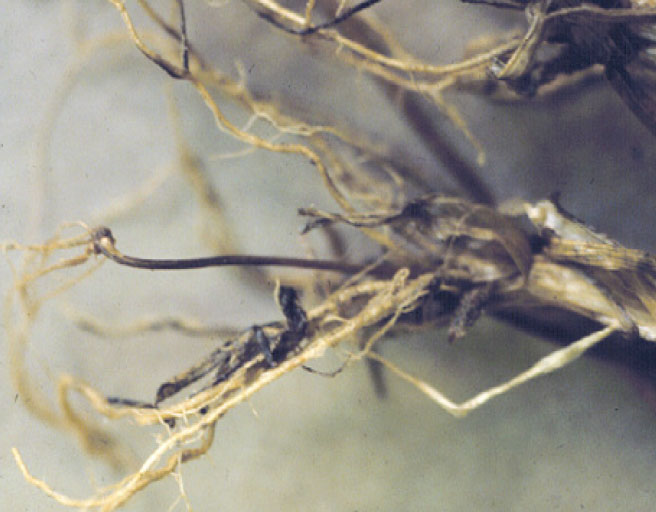
Common root rot
Common root rot causes premature death of wheat resulting in patches of white heads scattered throughout a field. Infected plants are often dark at the base and have poor root development. A key diagnostic feature of common root rot is dark-brown lesions on the thin stem extending from the base of the plant to the remnant of the seed. This thin stem is known as the “subcrown internode.” Healthy subcrown internodes should be cream colored and firm.
Management: Crop rotation, control grassy weeds.
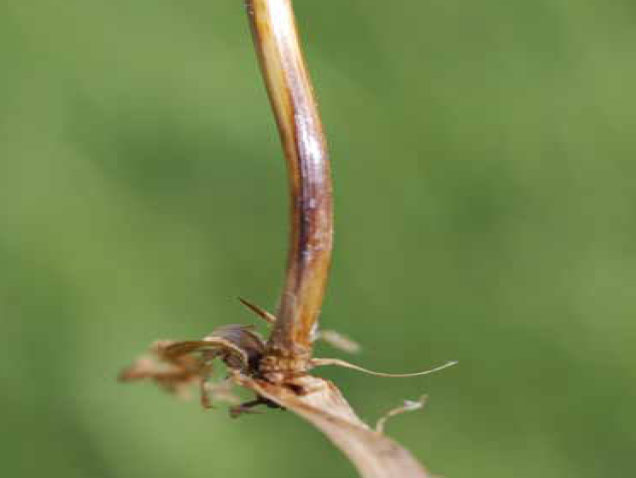
Fusarium root, crown and foot rots
Fusarium root, crown and foot rots cause patches of wheat to die prematurely, resulting in areas of white heads within a field. Infected plants are typically brown at the base and have poor root development. During advanced stages of the disease, the Fusarium fungus often produces a pink, cottony growth inside the lower portions of the stem. Often, the disease is most severe after prolonged periods of dry weather.
Management: Crop rotation, control grassy weeds.
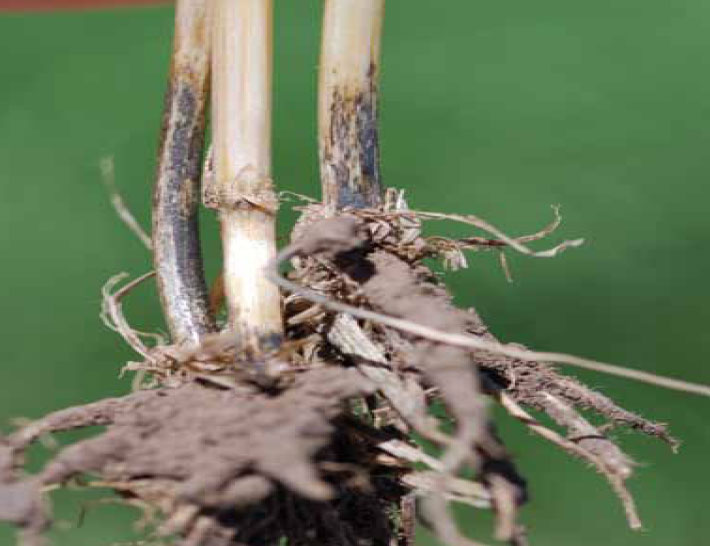
Take-all
This fungal disease causes wheat to die prematurely, resulting in patches of white heads in otherwise green fields of wheat. Plants infected by take-all normally have a black discoloration of the lower stem and roots. Frequently, the disease is most severe in wet areas of a field and near field edges where the fungus survives in association with grassy weeds.
Management: Crop rotation, control grassy weeds.

